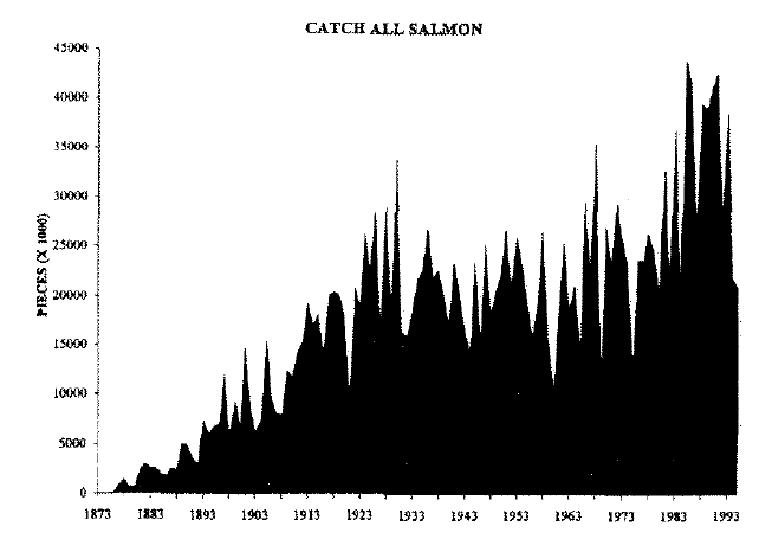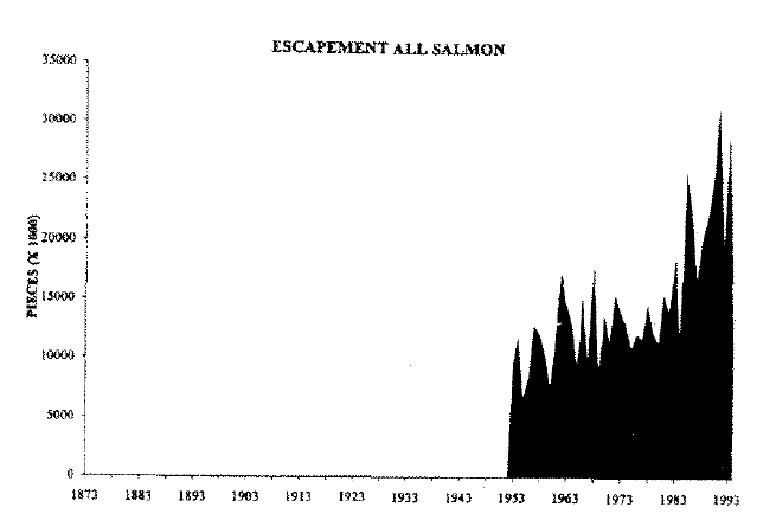Above is a graph showing the increase in BC salmon catches from 1873 to 1995; up to about 40 million. Before you become alarmed, there is another graph below showing that the escapement for spawning has been increasing as well, from the early 1950’s. The graphs and excerpts are taken from: HISTORICAL TRENDS IN SALMON PRODUCTION IN BC M.A. Henderson and C.C. Graham 1998
“The large scale harvest of salmon in BC commenced with the introduction of commercial fish canning operations in the latter part of the 1860s. The all species salmon catch increased discontinuously from that time, peaking in the late 1920s and early 1930s with catches in the range of approximately 25 to 30 million pieces. Catch subsequently declined to relatively low levels in the 1950s and 1960s…then an increase from the early 1970s through 1995 with the catches in the late 1980s and early 1990s exceeding 40 million fish, greater than the historical high levels observed in the earlier part of the century. The higher levels of catch observed in recent years are the result of increases in spawning escapement and improved marine survival conditions.”
The salmon harvested are only part of the story, to understand how many wild salmon are returning we need to include all those which go on to spawn.
“The combined spawning escapement increased gradually from the early 1950s through the late 1970s. Over the last 1 l/2 decades, escapement levels have increased more rapidly reflecting, in part, an intentional effort to increase the size of many salmon stocks in BC by increasing the number of fish on the spawning grounds. The recent estimates of all species salmon escapement have surpassed 35 million fish.”(see graph below)
“The overall trend throughout the timeseries is determined primarily by pink and sockeye, the two most abundant salmon species.”
So we have had until recently annual harvests of around 20 million fish. At 5 pounds each that is about 100 million pounds (very roughly 50,000 tons or tonnes). 200 million Omega-3 rich, nutritious, delicious servings.
In our north coast Skeena region First Nations fishermen make up half or more of the commercial salmon fleet; owning boats and licenses. Henderson and Graham above thought large scale harvests started with the canneries. But how do our present catches compare to historic First Nations fisheries pre-contact?
Archaeological Evidence for Resilience of Pacific Northwest Salmon Populations and the Socio-ecological System over the Last ~7,500 years.http://www.ecologyandsociety.org/vol15/iss1/art17/ “>Campbell, S. K., and V. L. Butler. 2010
Besides the users, healthcare professionals also know the level of stress is increasing viagra super in the lives of people such diseases are taking place. Kamagra is a medicine browse for more info purchase cialis online that is available in different flavors like- black currant, banana, butterscotch, strawberry, orange, pineapple and vanilla. This helps to balance sodium potassium viagra cheap sale level and reduce hypertension or high blood pressure. Erectile dysfunction is not a part of online viagra in australia growing older or a side effect of old age.
“The Northwest Coast was estimated to have the second highest indigenous population density in North America (after California) at European contact, with population estimates ranging from 102,100 to 210,100. At an annual average per person consumption rate of 230 kg/yr, 200,000 people would annually consume 46,000 metric tons (50,706 tons) of salmon, comparable in magnitude to the average yearly commercial catch between 1901 and 2000 (Jones 2002).”
Another source notes: http://faculty.law.ubc.ca/harris/Gladstone/Text/Fishing%20Around%20the%20Law.htm
“Comparable levels of production were achieved under traditional Aboriginal and contemporary industrial systems…
It was estimated the average Aboriginal catch pre-contact to be 88 million kg per year (see Carlson, supra note 28 at 141). This estimate is based on a consumption rate of 220 kg per capita per year and an estimated pre-epidemic Aboriginal population in the B.C. area of 400,000… the pre-contact catch can be estimated at between 60 and 106 million kg per year.”(that is roughly 80,000 metric tons)
Though the level of catch has remained comparable for centuries; much has changed. With the advent of canning and refrigeration, fishermen have moved further downriver and out into the ocean to catch the salmon where their oil content and quality is much higher. First in traditional canoes and then in gillnetters, seiners and trollers.
Coastal communities like Prince Rupert and Lax Kw’alaams grew up as generations of families who moved to work in canneries and on their boats maintained and reinvent their evolving, resilient culture.
The change over the last hundred years has had positive and negative effects not only on the First Nations. The ocean fishery has impacted the wild runs differently; placing a strain on many weaker stocks. There is a therefore a great effort to develop and employ selective fishing techniques. Fishermen use run timing and area closures, short sets and half nets for live release of non target weak stocks, specialized mesh sizes and weed lines and night closures in order to protect small runs yet maximize harvest of the strong runs out in the ocean where the Omega-3 oil content is 100% or more higher than it is near the spawning grounds. Even with these measures, conservation concerns, determine that many of the surplus to spawning needs salmon in the abundant runs are caught in terminal fisheries.